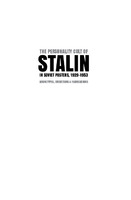The personality cult of Stalin in Soviet posters, 1929–1953: Archetypes, inventions and fabrications
| dc.contributor.author | Pisch, Anita | |
| dc.date.accessioned | 2017-02-17 00:00:00 | |
| dc.date.accessioned | 2020-04-01T13:51:53Z | |
| dc.date.available | 2020-04-01T13:51:53Z | |
| dc.date.issued | 2016 | |
| dc.identifier | 624293 | |
| dc.identifier | OCN: 953930040 | en_US |
| dc.identifier.uri | http://library.oapen.org/handle/20.500.12657/31868 | |
| dc.description.abstract | From 1929 until 1953, Iosif Stalin’s image became a central symbol in Soviet propaganda. Touched up images of an omniscient Stalin appeared everywhere: emblazoned across buildings and lining the streets; carried in parades and woven into carpets; and saturating the media of socialist realist painting, statuary, monumental architecture, friezes, banners, and posters. From the beginning of the Soviet regime, posters were seen as a vitally important medium for communicating with the population of the vast territories of the USSR. Stalin’s image became a symbol of Bolshevik values and the personification of a revolutionary new type of society. The persona created for Stalin in propaganda posters reflects how the state saw itself or, at the very least, how it wished to appear in the eyes of the people. The ‘Stalin’ who was celebrated in posters bore but scant resemblance to the man Iosif Vissarionovich Dzhugashvili, whose humble origins, criminal past, penchant for violent solutions and unprepossessing appearance made him an unlikely recipient of uncritical charismatic adulation. The Bolsheviks needed a wise, nurturing and authoritative figure to embody their revolutionary vision and to legitimate their hold on power. This leader would come to embody the sacred and archetypal qualities of the wise Teacher, the Father of the nation, the great Warrior and military strategist, and the Saviour of first the Russian land, and then the whole world. This book is the first dedicated study on the marketing of Stalin in Soviet propaganda posters. Drawing on the archives of libraries and museums throughout Russia, hundreds of previously unpublished posters are examined, with more than 130 reproduced in full colour. The personality cult of Stalin in Soviet posters, 1929–1953 is a unique and valuable contribution to the discourse in Stalinist studies across a number of disciplines. | |
| dc.language | English | |
| dc.subject.classification | thema EDItEUR::1 Place qualifiers::1Q Other geographical groupings: Oceans and seas, historical, political etc::1QB Historical states, empires, territories and regions::1QBD Historical states, empires, territories and regions: Europe::1QBDR USSR, Soviet Union | en_US |
| dc.subject.classification | thema EDItEUR::A The Arts::AK Design, Industrial and commercial arts, illustration::AKL Illustration and commercial art::AKLP Poster art | en_US |
| dc.subject.classification | thema EDItEUR::J Society and Social Sciences::JP Politics and government::JPH Political structure and processes::JPHL Political leaders and leadership | en_US |
| dc.subject.classification | thema EDItEUR::J Society and Social Sciences::JP Politics and government::JPW Political activism / Political engagement::JPWC Political campaigning and advertising | en_US |
| dc.subject.other | stalin | |
| dc.subject.other | soviet russia | |
| dc.subject.other | marketing | |
| dc.subject.other | poster art | |
| dc.subject.other | propoganda | |
| dc.subject.other | Cult of personality | |
| dc.subject.other | Joseph Stalin | |
| dc.subject.other | Moscow | |
| dc.subject.other | Propaganda | |
| dc.subject.other | Vladimir Lenin | |
| dc.title | The personality cult of Stalin in Soviet posters, 1929–1953: Archetypes, inventions and fabrications | |
| dc.type | book | |
| oapen.identifier.doi | 10.22459/PCSSP.12.2016 | |
| oapen.relation.isPublishedBy | ddc8cc3f-dd57-40ef-b8d5-06f839686b71 | |
| oapen.relation.isbn | 9781760460624 | |
| oapen.remark.public | Relevant Wikipedia pages: Cult of personality - https://en.wikipedia.org/wiki/Cult_of_personality; Joseph Stalin - https://en.wikipedia.org/wiki/Joseph_Stalin; Moscow - https://en.wikipedia.org/wiki/Moscow; Propaganda - https://en.wikipedia.org/wiki/Propaganda; Soviet Union - https://en.wikipedia.org/wiki/Soviet_Union; Vladimir Lenin - https://en.wikipedia.org/wiki/Vladimir_Lenin | |
| oapen.identifier.ocn | 953930040 |

